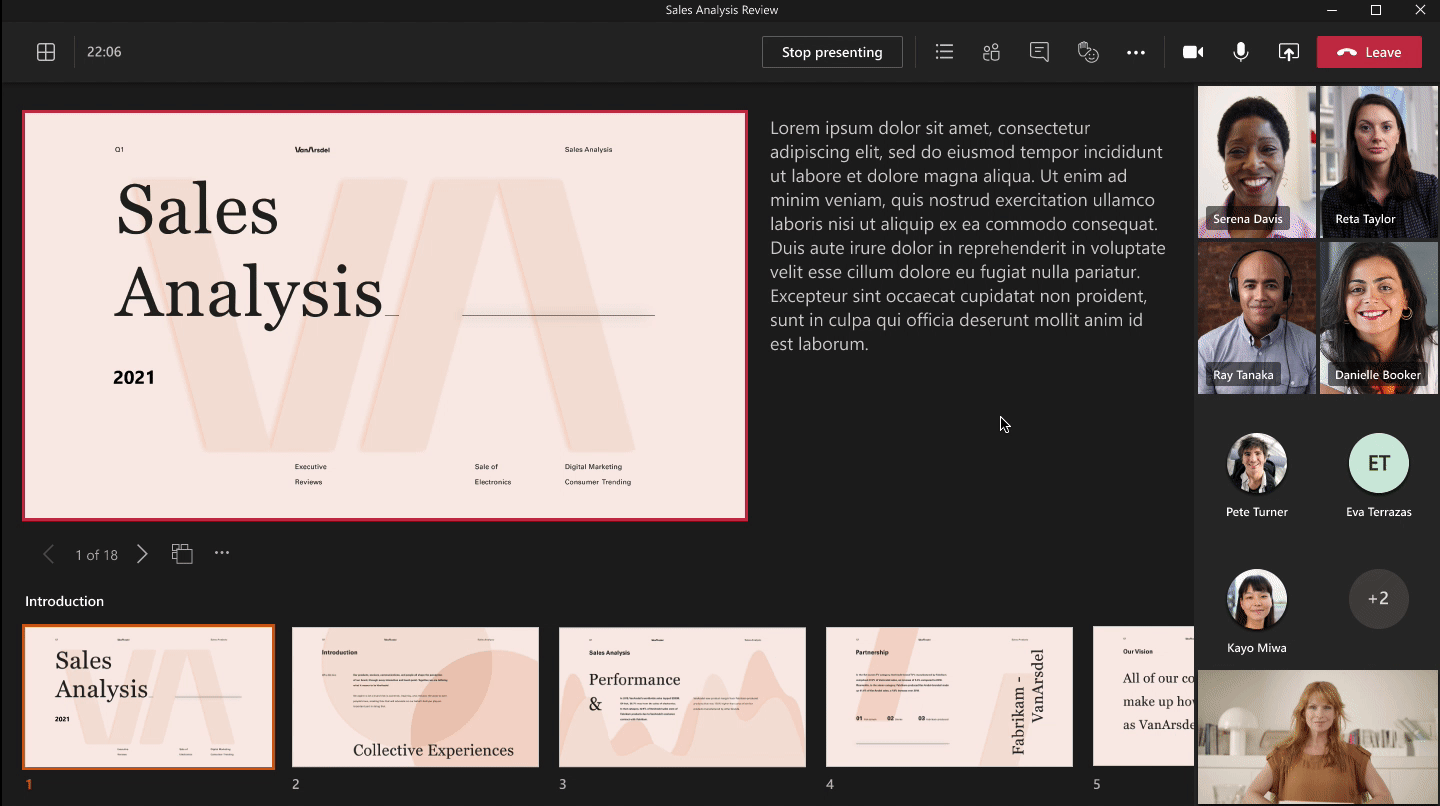What a busy couple of days! Ignite (2-4 March) 2021 has been a blast and there’s lots of new innovations in the Microsoft space that I’d like to share with you. This Ignite, like last year, was a fully digital event which allowed access to events that weren’t governed by Pacific Standard Time.
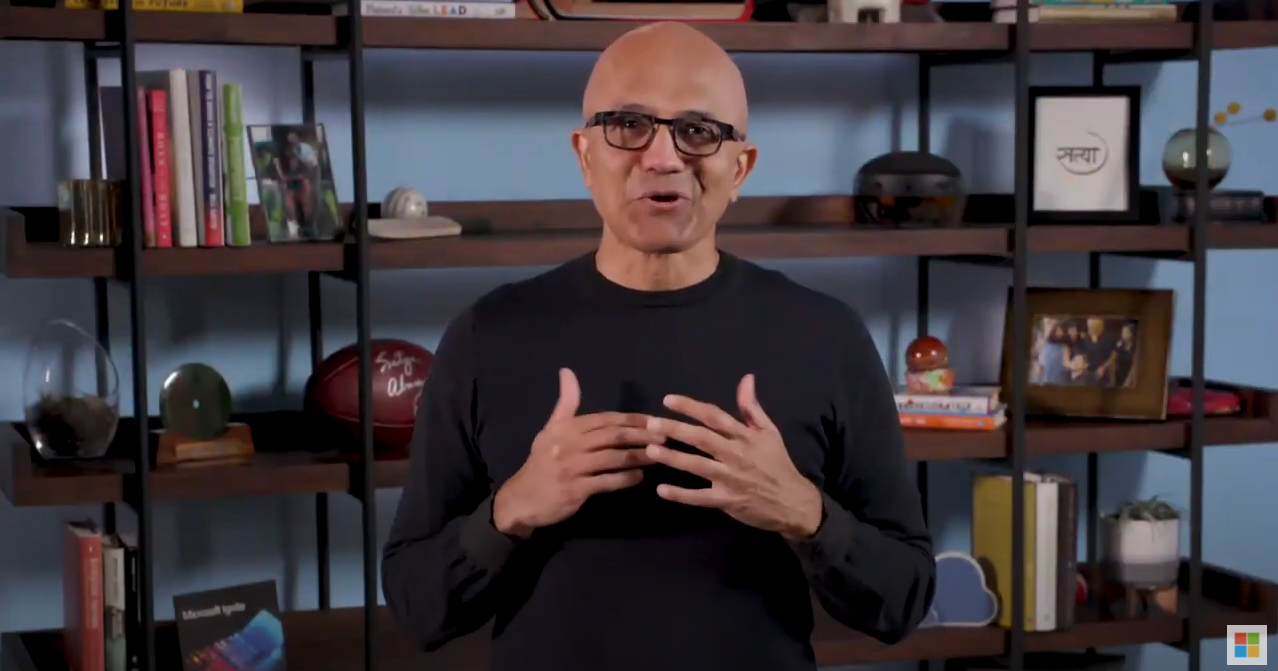
Image Credit – Microsoft via YouTube
First up is the opening keynote from Microsoft CEO, Satya Nadella (@satyanadella). After a decade of digital transformation (heavily accelerated in the last year) we have made the cloud work for us and the successes it has enabled. However, we must reflect on how the cloud will change over the decade and by extension how that will enable economic and societal growth. We must enable all to be able to contribute to that, so it is not just IT professionals but everyone. Through the advent of low/no-code technologies such as Microsoft’s Power Platform and M365 we can really accelerate that digital transformation. A prime example of this, is the implementation of PowerApps at London Heathrow International Airport. Through the creation of 30 apps by citizen developers, this has eliminated 75,000 pages of paperwork and reduced the time required for data entry by almost 1000 hours. With the following five principals, we can enable this change:
- Ubiquitous and decentralized computing – Every organization, regardless of size or geographic location will require more compute power. This should be readily available, everywhere. This doesn’t necessarily mean moving everything to the cloud but utilizing other opportunities such extending Azure technology to our own data centers through Azure Arc. We are at peak centralization and that should change to enable this transformation.
- Sovereign data and ambient intelligence – The volume, variety and velocity of data is going to intensively grow over the next decade. This will be relevant with the cloud, but even more so with the edge; computing closer to where it’s needed, driving the decentralized approach. Data governance, sovereignty and provenance will take on new importance. The next generation of artificial intelligence and machine learning will be groundbreaking whilst conserving data privacy. One interesting point that he made, was that “Business logic will move from code that is written to code that is learned by data…” This mindset considers:
- Where the data is stored
- Does the way the data is stored meet compliance and regulatory requirements?
- Who/what should have access to the data?
- Is the data stored securely?
- Is the data usable? i.e. for reporting
- Validity/reliability of the data
- Where has the data come from
- Has anything changed in the data, if so, what?
- How confident are we that the data is accurate?
- Empowered creators and communities everywhere – We must evolve from a consumption-based society (Online Shopping, Social Media, Netflix etc) to allow for more creation. To do this we need to “democratize” creation. As I alluded to earlier, we need to provide better access to skills, tools, platforms, connections, and collaboration. This will drive innovation for end user computing.
- Economic opportunity for the global workforce – The needs to be a continuous feedback loop of work, skills, learning and credentials for the jobs of today and tomorrow. This will help enable career advancement for all workers. We need flexibility on when/where/how people work.
- Trust by design – We must have ethical principles that govern the design, development, and deployment of artificial intelligence. We must architect these solutions to incorporate zero trust principles Zero Trust Security (microsoft.com). These solutions must respect the rights and privacy of citizens.
With this vision in mind, the next presentation was for the introduction of Microsoft Mesh by Alex Kipman (Technical Fellow – Mixed Reality & AI at Microsoft @akipman) which aims to disrupt the world of mixed reality in the same way that Xbox Live disrupted console gaming. Microsoft Mesh has expanded on all the advancements we have made in the Mixed Reality space so far. Up until this point, mixed reality has been a ‘single player’ experience, to put it into gaming terms. Microsoft Mesh now enables mixed reality users to collaborate in the same space. As well as evolving conferences/meetings etc it also can improve the gaming experience. Pokemon Go, a popular mixed-reality app available on smartphones is now fully mixed-reality ready so you can play wearing your VR headset whilst interacting with other players at the same time. To keep adding to the surprises, James Cameron whose movie directing credentials include Avatar, The Abyss, The Terminator, Solaris, and Titanic joined Alex in the keynote, also through mixed reality. Microsoft Mesh will enable advancements in deep sea exploration that haven’t been possible before. As underwater camera technology develops, we can map out the ocean floor. Scientists can then visit the point of interest virtually, before potentially endangering their lives by physically going to the location. This is all supported by a new generally available Azure service, Azure Remote Rendering.
Further demonstrating Microsoft’s current approach to being platform agnostic, Mesh will not only be available on first-party devices (Microsoft created), other smartphones, tablets and VR headsets will have the capability to run this software too. As you can see in my tweet below, during the keynote, the audience were actively participating with their own Hololens 2 headsets. As this technology advances over the decade, will we see in-person conferences become a permanent fixture of the history books, superseded by mixed reality? This technology would also be suitable for smaller scenarios such as an internal company townhall, so the participants have that sense of connection that you don’t get when it is just presented virtually through something like a Teams Live Event.
Microsoft Mesh is so cool! #MSIgnite pic.twitter.com/aBfLPGmVX0
— Joe Hubbert (@JoeHubbert) March 2, 2021
Next up was the keynote by Jared Spataro (CVP – Microsoft 365 at Microsoft @jared_spataro) presented new developments on how Microsoft 365 will enable organizations to be successful as our lives adjust, once again post-pandemic. Whether employees will be fully remote, office based full time or have a hybrid working pattern, we need to ensure that collaboration is as effective as possible. With that in mind, he announced new features for Microsoft Teams such as presenter view and reporter modes, pictured below. Since working through this ‘new normal’ I have encountered a couple of challenges when presenting remotely through Teams, I don’t feel engaged with my audience. When using the current native Teams PowerPoint sharing mode, it only shows the slides on the screen and I’m not able to see my presenter notes. There is a workaround for this where you present your PowerPoint slideshow as normal in the PowerPoint application, sharing the slideshow through Teams on one screen and having your notes on the other. With the new presenter mode, you can present your slides within the Teams window, notes appear alongside for the presenter, your video feed appears on the slides and you can see your audience which breaks down that audience-presenter barrier when presenting. You can also show the video feeds of co-presenters in side-by-side mode to build upon the engagement.
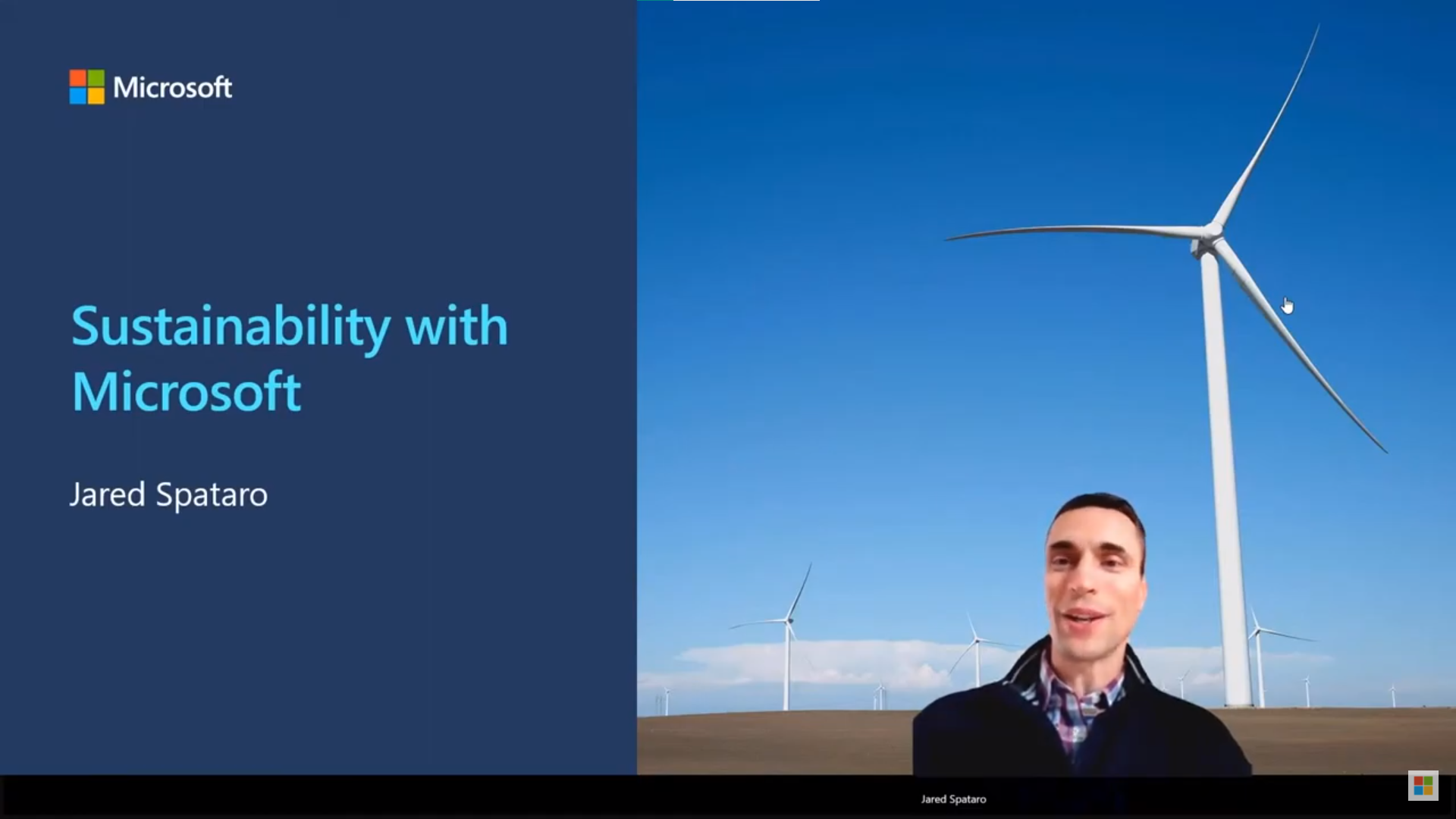
Image Credit – Microsoft via YouTube
After this presentation, I attended a table talk on the subject of ‘Future Workplace’ which was fascinating. This was the busiest Teams meeting I have attended so far with over 300 participants (note to self, invest in new computer hardware that can keep up). To the surprise of all attendees, Jared Spataro also joined this meeting and offered more insights into the future workplace building upon his keynote. Thanks to Karoliina Kettukari (@kettukari) et al for organising!

Image courtesy of Anna Chu – @_achu
To help drive this vision of better collaboration and adoption of future ways of working, Microsoft have published this site which offer guidance of how to implement M365 into your organization (Microsoft 365 Adoption | Microsoft). Thanks for the tip, Karuana Gatimu (@Karuana)!
Later, Charles Lamanna (CVP – Low Code Application Platform at Microsoft @clamanna) announced innovations in the Power Platform space following on from Satya’s keynote setting the tone on how we should enable all to drive innovation in the cloud. Power Automate, the low-code platform for automation of business processes now has a desktop client for development like its Power BI cousin. This not only allows you to develop centralized automated processes but also automating workflows on your desktop itself, pretty cool right! You can find out more and download for free, here. A rebranding of the canvas apps formula language was announced, this is now known as Power Fx. It is being made available as open source. There is now a capability to develop code outside of the platform using tools such as Visual Studio Code.
Rohan Kumar (CVP – Azure Data at Microsoft @RohanKData) announced the Data Modernization capability in public preview. This allows organizations to discover & assess on-premises SQL servers, get target KSU recommendations and monthly cost estimates all from within the Azure portal. Just in the context of Azure SQL, there are over seven million databases deployed, 200% YoY growth for SQL Server VMs and 70% YoY grown for SQL Managed Instances. That’s huge. Since last summer, Microsoft has seen a 350% increase in consumption of Azure Synapse Analytics and a 320% increase in petabyte scale workloads. Azure Synapse Pathway (Public Preview) was announced to help customers accelerate their migration from their existing datastores/ETL processes from products such as Google BigQuery, Snowflake, Teradata, Redshift and SQL Server. This new product aims to reduce migration time from months to minutes which subsequently reduces costs. There is an engine which analyses your code and can automatically convert it to T-SQL. Rohan gave an update on the stats of how customers such as Pepsi and Airbus have been using AI services in Azure. Per month, they are now seeing ten billion inferences in Azure Machine Learning (400% growth in 1 year!), fifty-three billion transactions in Cognitive Services (30% growth since last year), twenty-four billion queries in Cognitive Search and three billion messages in Azure Bot Service. A new cognitive service has been announced, ‘Form Recognizer’ (Public Preview) which will enable customers to automatically process semi-structured data such as invoices delivered through PDF/Word Documents and other file types. This is something that I know will become increasingly useful in the years to come as we look to improve data collection techniques.
The final announcement was ‘Semantic Search’ for Cognitive Search which aims to improve users’ search engine experiences. In the example given, the user is searching ‘What are the maternity ward’s visiting hours?’ with results that aren’t relevant to them. In the backend, natual language processing and machine learning models look at what the user is really looking for. It will split out the key words from the query and look for other related terms. In the case of ‘maternity ward’ it will find other terms such as ‘baby’, ‘mother’ and ‘hospital’. It will do the same with the term ‘visiting hours’. It will then look at the underlying data to deliver the most relevant answer.
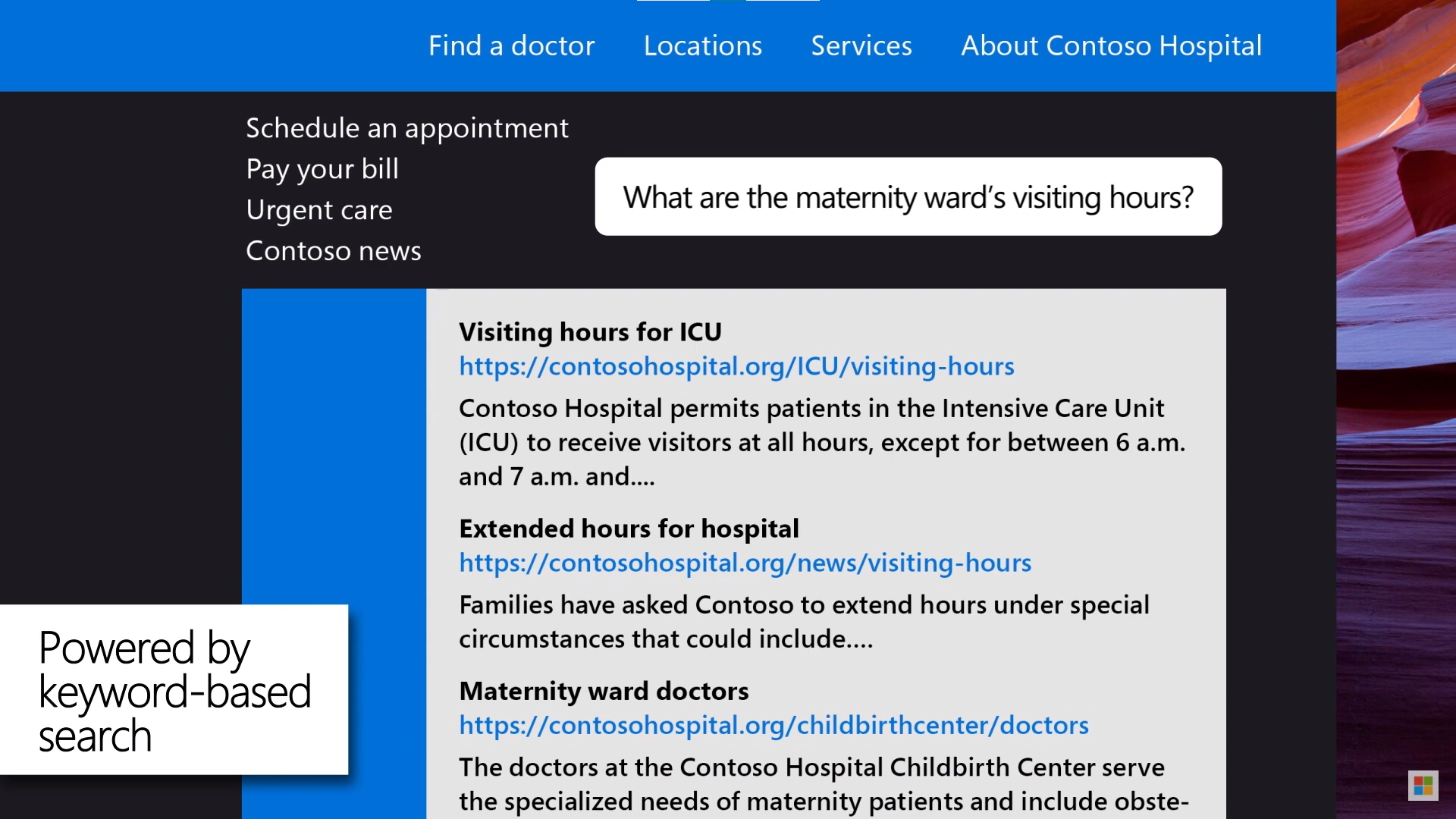
(Current Gen Search – Before) – Image Credit: Microsoft via YouTube
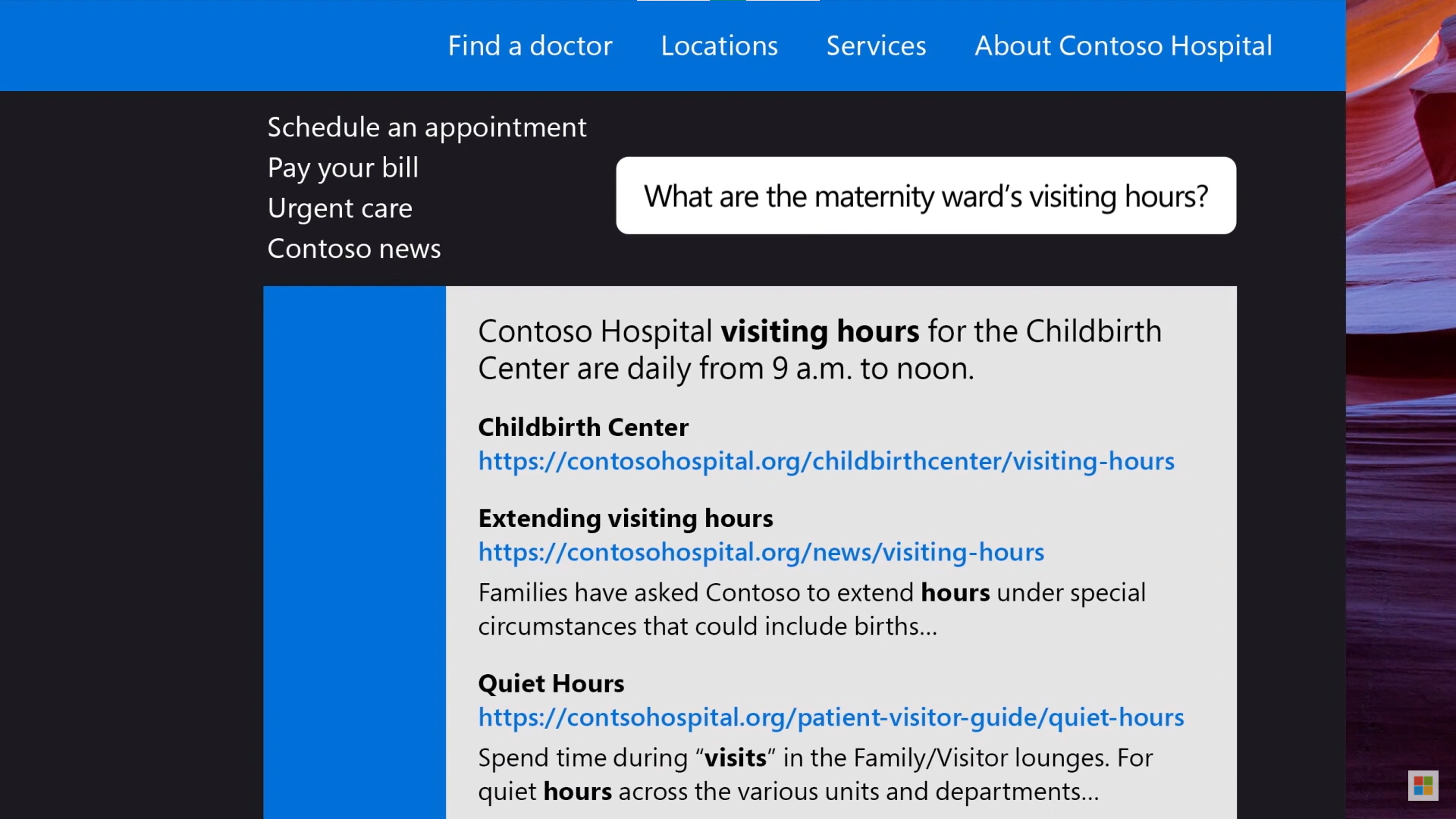
Semantic Search (After) – Image Credit: Microsoft via YouTube
With these new advancements, we can help our organizations to be more data driven using tools such as Microsoft’s Power BI. There was a great presentation on this by Arun Ulagaratchagan (CVP – Intelligence Platform @arunulag). We are already starting to see this change in culture with over 260,000 organizations actively using Power BI every month. This global growth is helped by there being over fifty datacenters worldwide and the service being available in forty-three languages. On top of that, there are over 1.4 million members of the Power BI Community who host over three hundred user groups. This community of customers helps drive innovation from both the customers and Microsoft. There are 23,000 active ideas on UserVoice for Power BI with 95,000 users actively voting and 500,000 votes on these ideas. One aspect of Power BI I like the most is the frequent updates. Every month new features will be added, not only created by Microsoft but members of the community too. In the February 2021 Gartner Magic Quadrant for Analytics and Business Intelligence Platforms, Power BI is once again leading in completeness in their vision with a strong ability to execute. To assist the new data-driven culture, Power BI must be integrated into our collaboration tools such as Microsoft Teams. Interoperability with Microsoft Excel will help drive user adoption by long-term Excel users. Arun states that he likens Power BI to be the “PowerPoint for Data” as in it should be easy for regular users of the Microsoft Office system to pick up Power BI easily (although sadly that’s not always the case). Solutions such as PowerApps can be integrated into reports so the journey between insights and action is seamless. Power BI is certified against 119 local and international compliance standards. It also has thirty-four local and international industry certifications. The network security, data encryption and data loss prevention capabilities enable customers to be confident that their Power BI environments will be both compliant and secure. The big announcement out of this presentation though is the general availability of Power BI Premium per user for April 2021, costing only $20 per user/month which is much cheaper than I was expecting given the capabilities that this gives Power BI users.
There were two big announcements made on security in Azure Active Directory. Passwordless Authentication is now generally available. That is big news. Passwords can easily become compromised so with replacing authentication with either the Microsoft Authenticator app or a FIDO2 device such a YubiKey this will offer huge advancements. Secondly, temporary access passes were allowed for public preview. This will enable authorized parties’ temporary access to your environment which will then expire with no involvement from the administrator. The FY20 Digital Defense report was also mentioned which has in-depth research on the current threats, it’s worth a read and can be accessed here.
There are other notable announcements made at Ignite that I couldn’t write about in this post:
- Windows Server 2022 – Public Preview
- Azure Communication Services – Generally Available
- Trusted launch for Azure virtual machines – Public Preview
- Universal Print – Generally Available
- Azure Firewall Premium – Public Preview
- Azure Migrate PowerShell module – Public Preview
- Azure Migrate Enhancements – Public Preview
- Azure Stream Analytics – Generally Available
- Windows Admin Center (Azure Portal) – Public Preview
Finally, I just wanted to say a huge shoutout to the hosts, Karuana Gatimu (@Karuana), Rick Claus (@rickster_cdn), Dona Sakar (@donasakar), Seth Juarez (@sethjuarez), Christina Warren (@filmgirl) and Joey Snow (@joeysnow). You have all helped this virtual conference a truly global event. Seth, your dad jokes were amazing. Keep it up.
